Evaluation of Ultra-High-Performance Concrete Columns at High Temperatures after 180 Days of Curing
Abstract
:1. Introduction
2. Materials and Methods
3. Results
3.1. Losses of the Compressive Strength and Modulus of Elasticity Due to Exposure to High Temperatures
3.2. Behaviors of Columns Exposed to Elevated Temperatures
4. Conclusions
- Comparing the results obtained with those reported in the bibliography, it should be mentioned that the high strength of the UHPC may lead to a higher displacement and spalling than in conventional concretes, even considering the lower water/cement ratios.
- UHPC exposed to elevated temperatures suffered from external degradation, which gradually changed the cross-section of the columns due to spalling.
- Up to a temperature of 400 °C, the compressive strength increased by up to 30.5% concerning the reference value. On the other hand, the modulus of elasticity and density decreased for the reference values, with peak reductions of 30% and 6%, respectively.
- The test results pointed out that the quartz sand aggregate in the mixture was deleterious to concrete performance and induced spalling as temperatures reached approximately 600 °C.
- The loss of the concrete session did not occur immediately, and there was a progressive detachment of the concrete due to heating. Once a heated piece of concrete was loosened, a new surface was exposed and again, it was heated to the point of spalling. This phenomenon caused small cracks that were possible to hear during the tests.
Author Contributions
Funding
Data Availability Statement
Acknowledgments
Conflicts of Interest
References
- Christ, R. Proposição de um Método de Dosagem Para Concretos de Ultra Alto Desempenho (UHPC); Universidade do Vale do Rio dos Sinos: Unisinos, Brazil, 2019. [Google Scholar]
- Torregrosa, E.C. Dosage Optimization and Bolted Connections for UHPFRC Ties. Ph.D. Thesis, Universidad Politécnica de Valencia (UPV), Valencia, Spain, 2013. [Google Scholar]
- ACI. ACI Committee 239 Ultra-High Performance Concrete 2012 ACI Fall Convention; ACI Fall Convention: Toronto, ON, Canada, 2013; pp. 5–8. [Google Scholar]
- NF P18-470; Concrete—Ultra-High Performance Fibre-Reinforced Concrrte—Specifications, Performance, Production and Conformity. Association Française de Normalisation: La Plaine Saint-Denis, France, 2016; 94p.
- Perry, V.; Alberta, C.; Guilherme, A.P. Nova Fronteira Para o Concreto; Revista Estrutura: São Paulo, Brazil, 2019; pp. 25–33. [Google Scholar]
- Christ, R.; Tutikian, B. Study of pressure and curing temperature in reactive powder concretes (RPC) with different amounts of metallic microfibers. Rev. La Constr. 2013, 12, 30–38. [Google Scholar] [CrossRef]
- Resplendino, J. Ultra high performance concrete: New AFGC recommendations. In Designing and Building with UHPFRC; John Wiley & Sons, Inc.: Hoboken, NJ, USA, 2013; pp. 713–722. [Google Scholar] [CrossRef]
- Fehling, E.; Schmidt, M.; Walraven, J.; Leutbecher, T.; Frihlich, S. Ultra-High Performance Concrete UHPC: Fundamentals, Design, Examples; Wilhelm Ernst & Sohn: Hoboken, NJ, USA, 2015. [Google Scholar] [CrossRef]
- Bolina, F.L. Avaliação Experimental da Influência dos Requisitos de Durabilidade na Segurança Contra Incêndio de Protóptipos de Pilares Pré-Fabricados de Concreto Armado. Master’s Thesis, Universidade do Vale do Rio dos Sinos (UNISINOS), São Leopoldo, Brazil, 2016; 170p. [Google Scholar]
- Hennemann, G.G.; Gil, A.M.; Fernandes, B.; Bolina, F.L.; Tutikian, B.F. Avaliação teórico-experimental da influência da espessura de alvenaria na resistência ao fogo de sistemas verticais de vedação. Ambient. Const. 2017, 17, 183–195. [Google Scholar] [CrossRef]
- Kodur, V. Properties of Concrete at Elevated Temperatures; Hindawi Publishing Corporation: London, UK, 2014; pp. 1–15. [Google Scholar] [CrossRef]
- Xiong, M.X.; Liew, J.Y.R. Spalling behavior and residual resistance of fibre reinforced Ultra-High performance concrete after exposure to high temperatures. Mater. Constr. 2015, 65, 2–10. [Google Scholar] [CrossRef]
- Gil, A.; Pacheco, F.; Christ, R.; Bolina, F.; Khayat, K.H.; Tutikian, B. Comparative study of concrete panels’ fire resistance. ACI Mater. J. 2017, 114, 2017. [Google Scholar] [CrossRef]
- FIB. FIB 38—Fire Design of Concrete Structures; Fédération Internationale du Béton (FIB): Lausanne, Switzerland, 2008; Volume 38, p. 106. [Google Scholar] [CrossRef]
- Li, Y.; Tan, K.H.; Yang, E.H. Synergistic effects of hybrid polypropylene and steel fibers on explosive spalling prevention of ultra-high performance concrete at elevated temperature. Cem. Concr. Compos. 2018, 96, 174–181. [Google Scholar] [CrossRef]
- Zhang, D.; Dasari, A.; Hai, K. On the mechanism of prevention of explosive spalling in ultra-high performance concrete with polymer fibers. Cem. Concr. Res. 2018, 113, 169–177. [Google Scholar] [CrossRef]
- Dias, D.M.; Calmon, J.L.; Vieira, G.L. Polymeric fiber reinforced concrete exposed to fire. Rev. ALCONPAT 2020, 10, 36–52. [Google Scholar] [CrossRef]
- Sanchayan, S.; Foster, S.J. High temperature behaviour of hybrid steel–PVA fibre reinforced reactive powder concrete. Mater. Struct. Mater. Constr. 2016, 49, 769–782. [Google Scholar] [CrossRef]
- Choe, G.; Kim, G.; Gucunski, N.; Lee, S. Evaluation of the mechanical properties of 200 MPa ultra-high-strength concrete at elevated temperatures and residual strength of column. Constr. Build. Mater. 2015, 86, 159–168. [Google Scholar] [CrossRef]
- Zheng, W.; Wang, Y. Microstructure and mechanical properties of RPC containing PP fibres at elevated temperatures. Mag. Concr. Res. 2014, 66, 397–408. [Google Scholar] [CrossRef]
- Li, Y.; Pimienta, P.; Pinoteau, N.; Tan, K.H. Effect of aggregate size and inclusion of polypropylene and steel fibers on explosive spalling and pore pressure in ultra-high-performance concrete (UHPC) at elevated temperature. Cem. Concr. Compos. 2019, 99, 62–71. [Google Scholar] [CrossRef]
- Gravit, M.; Golub, E. Increase of fire resistance of reinforced concrete structures with polypropylene microfiber. In MATEC Web of Conferences; EDP Sciences: Yulis, France, 2018. [Google Scholar] [CrossRef]
- Adesina, A. Overview of the in fl uence of waste materials on the thermal conductivity of cementitious composites. Clean Eng. Technol. 2020, 2, 100046. [Google Scholar] [CrossRef]
- Abid, M.; Hou, X.; Zheng, W.; Hussain, R.R. High temperature and residual properties of reactive powder concrete—A review. Constr. Build. Mater. 2017, 147, 339–351. [Google Scholar] [CrossRef]
- Kodur, V.K.R.; Cheng, F.-P.; Wang, T.-C.; Sultan, M.A. Effect of strength and fiber reinforcement on fire resistance of high-strength concrete columns. J. Struct. Eng. 2003, 129, 253–259. [Google Scholar] [CrossRef]
- Bolina, F.L.; Gil, A.M.; Fernandes, B.; Hennemann, G.G.; Goncalves, J.; Tutikian, B.F. Influence of design durability on concrete columns fire performance. J. Mater. Res. Technol. 2020, 9, 4968–4977. [Google Scholar] [CrossRef]
- Manica, G.C.; Bolina, F.L.; Tutikian, B.F.; Oliveira, M.; Moreira, M.A. Influence of curing time on the fire performance of solid reinforced concrete plates. J. Mater. Res. Technol. 2020, 9, 2506–2512. [Google Scholar] [CrossRef]
- Lee, N.K.; Koh, K.T.; Park, S.H.; Ryu, G.S. Microstructural investigation of calcium aluminate cement-based ultra-high performance concrete (UHPC) exposed to high temperatures. Cem. Concr. Res. 2017, 102, 109–118. [Google Scholar] [CrossRef]
- Morales, D.S.; Ríos, J.D.; La Concha, A.M.D.; Cifuentes, H.; Jiménez, J.R.; Fernández, J.M. Effect of moderate temperatures on compressive strength of ultra-high performance concrete: A microstructurak analysis. Cem. Concr. Res. 2021, 140, 19. [Google Scholar] [CrossRef]
- Peng, G.F.; Chan, S.Y.N.; Anson, M. Chemical kinetics of C-S-H decomposition in hardened cement paste subjected to elevated temperatures up to 800 °C. Adv. Cem. Res. 2001, 13, 47–52. [Google Scholar] [CrossRef]
- Xuan, D.X.; Shui, Z.H. Rehydration activity of hydrated cement paste exposed to high temperature. Fire Mater. 2011, 35, 481–490. [Google Scholar] [CrossRef]
- Kahanji, C.; Ali, F.; Nadjai, A. Experimental study of ultra-high performance fibre reinforced concrete under ISO 834 fire. In Proceeding of the Ninth International Conference on Structures in Fire, Princeton, NJ, USA, 8–10 June 2016; DEStech Publications, Inc.: Lancaster, PA, USA, 2016; Volume 165. [Google Scholar] [CrossRef]
- Zhang, Y.; Wei, Y.; Bai, J.; Wu, G.; Dong, Z. A novel seawater and sea sand concrete filled FRP-carbon steel composite tube column: Concept and behaviour. Compos. Struct. 2020, 246, 13. [Google Scholar] [CrossRef]
- Mehta, P.K.; Monteiro, P.J. Concreto microestrutura, propriedades e materiais. In Ibracon, 4th ed.; Ibracon: São Paulo, Brazil, 2014. [Google Scholar]

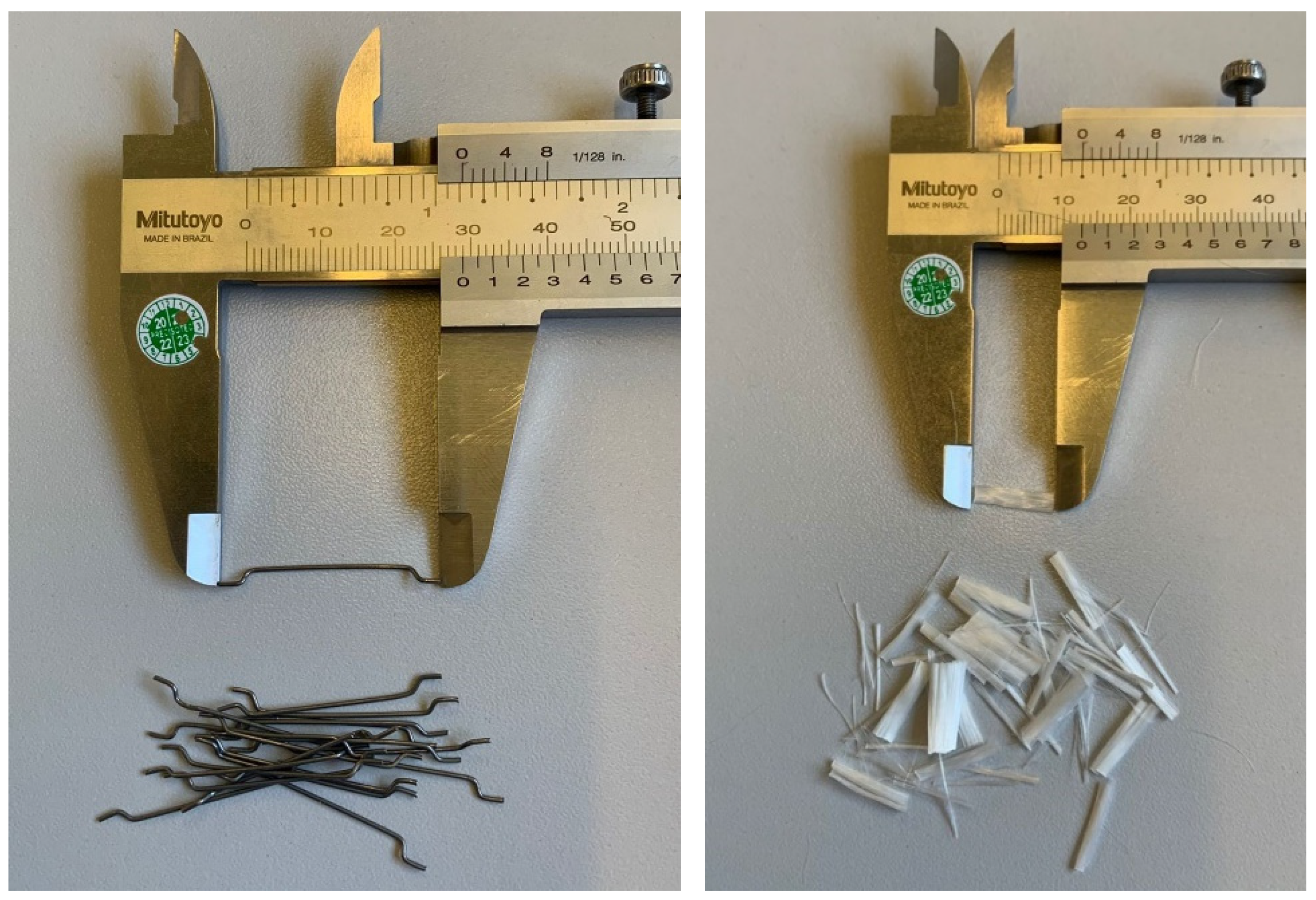


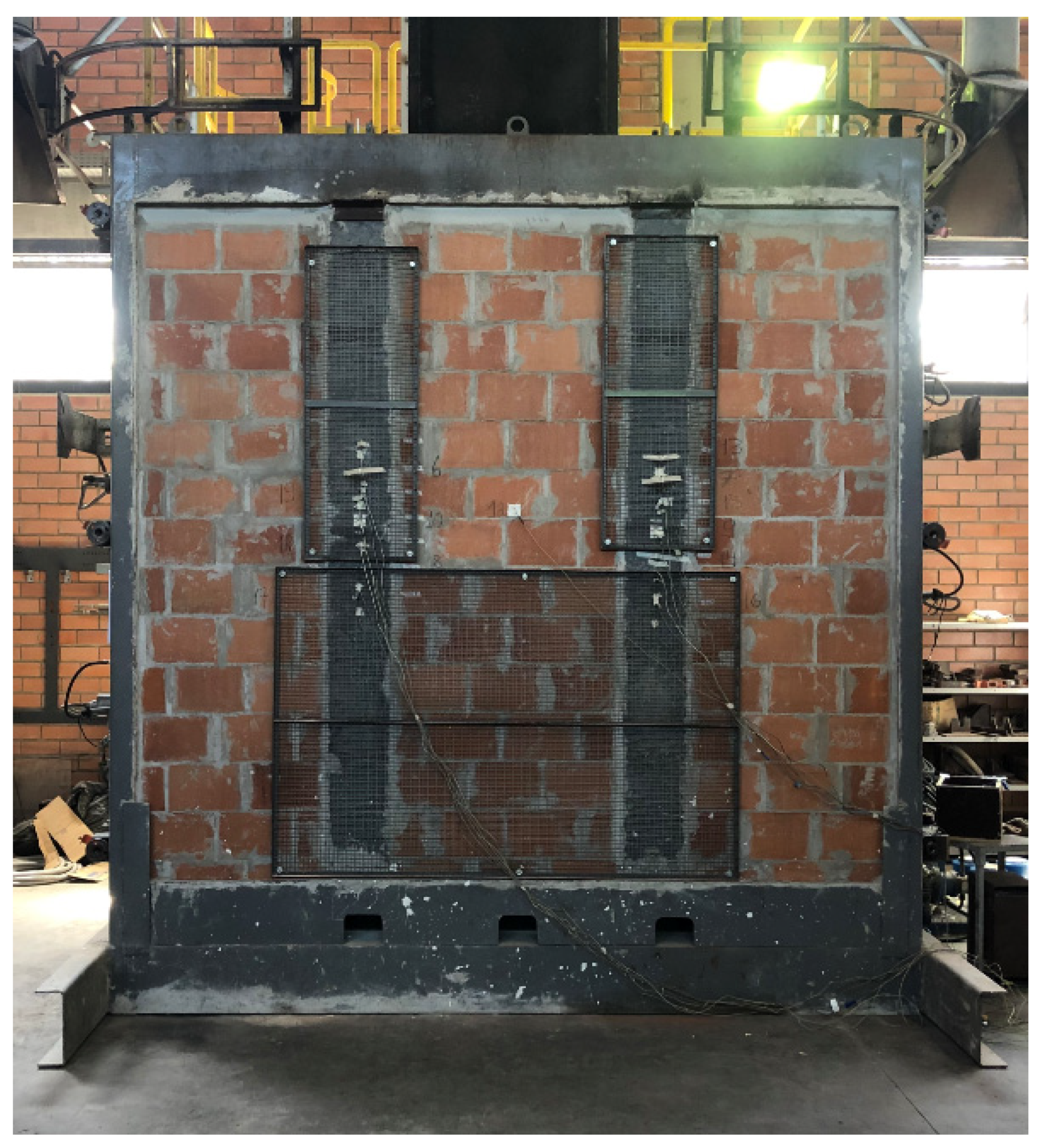

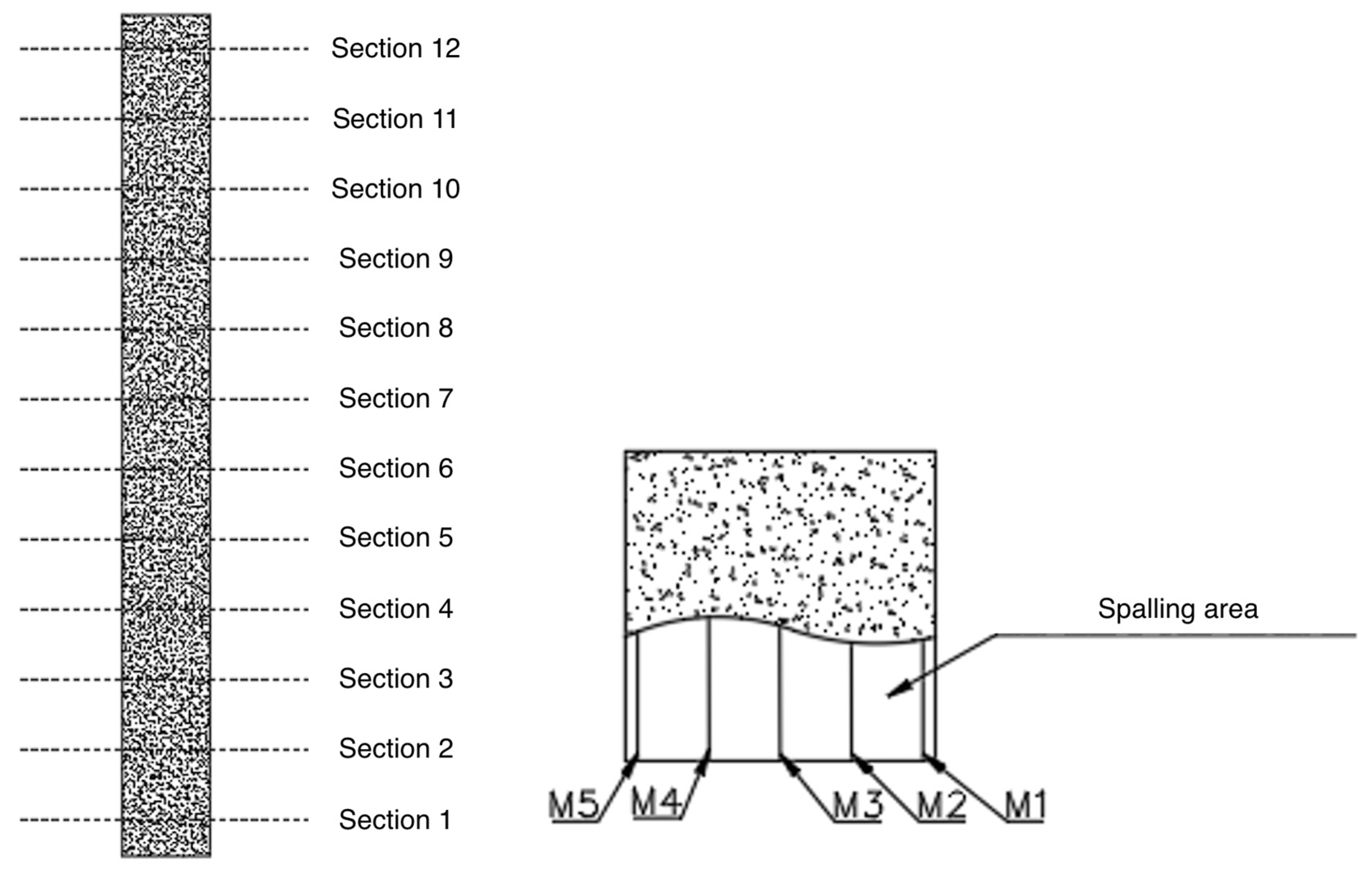
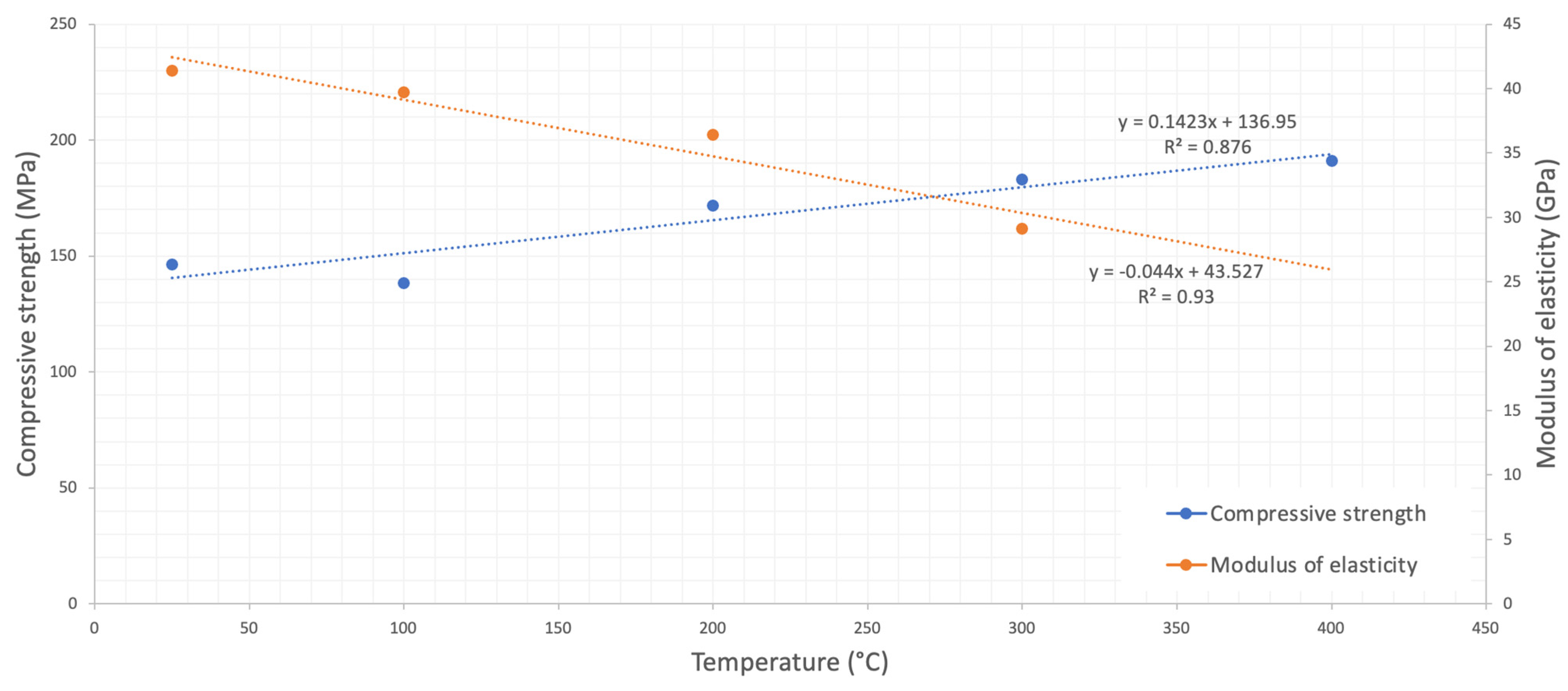
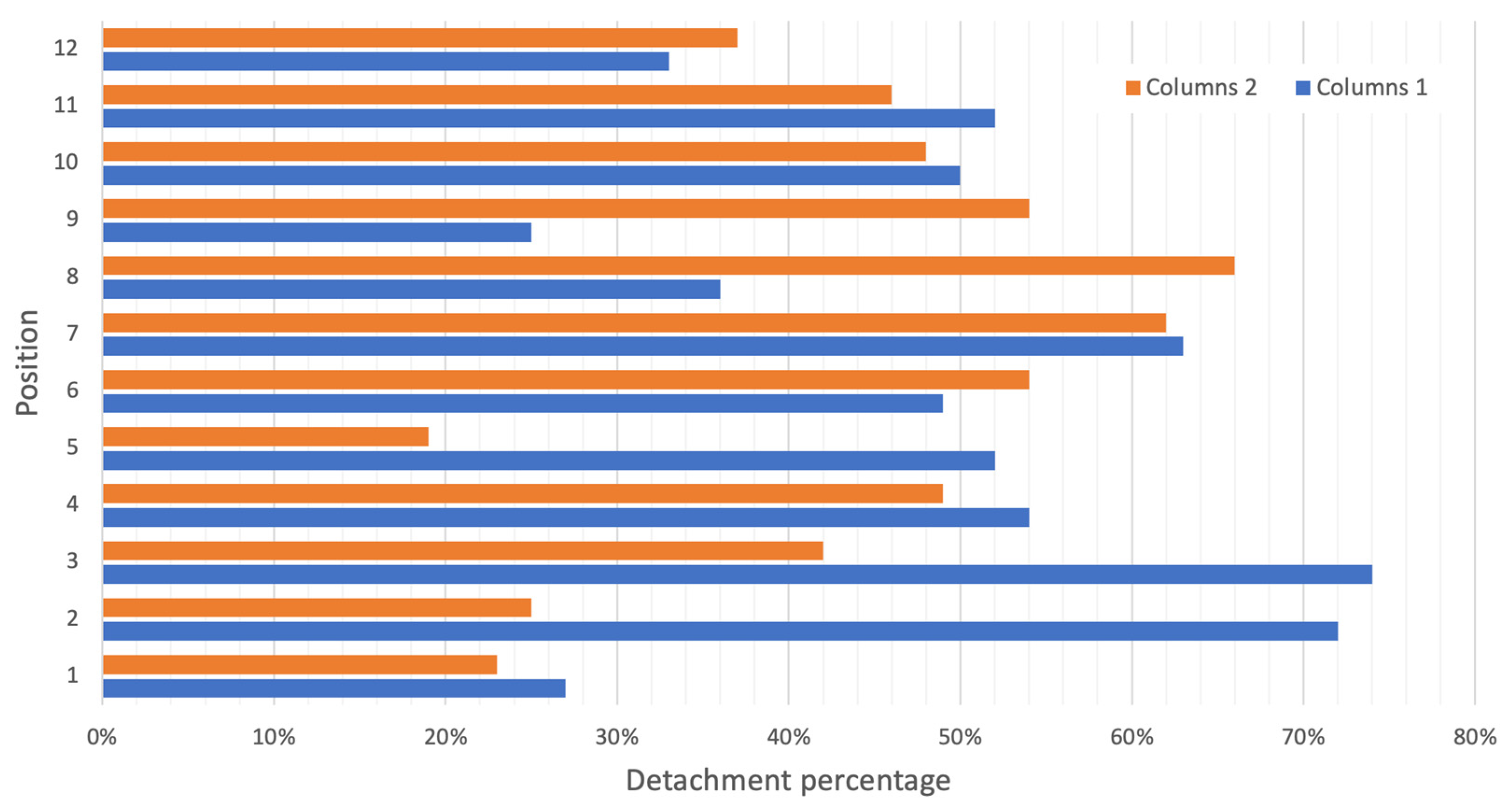
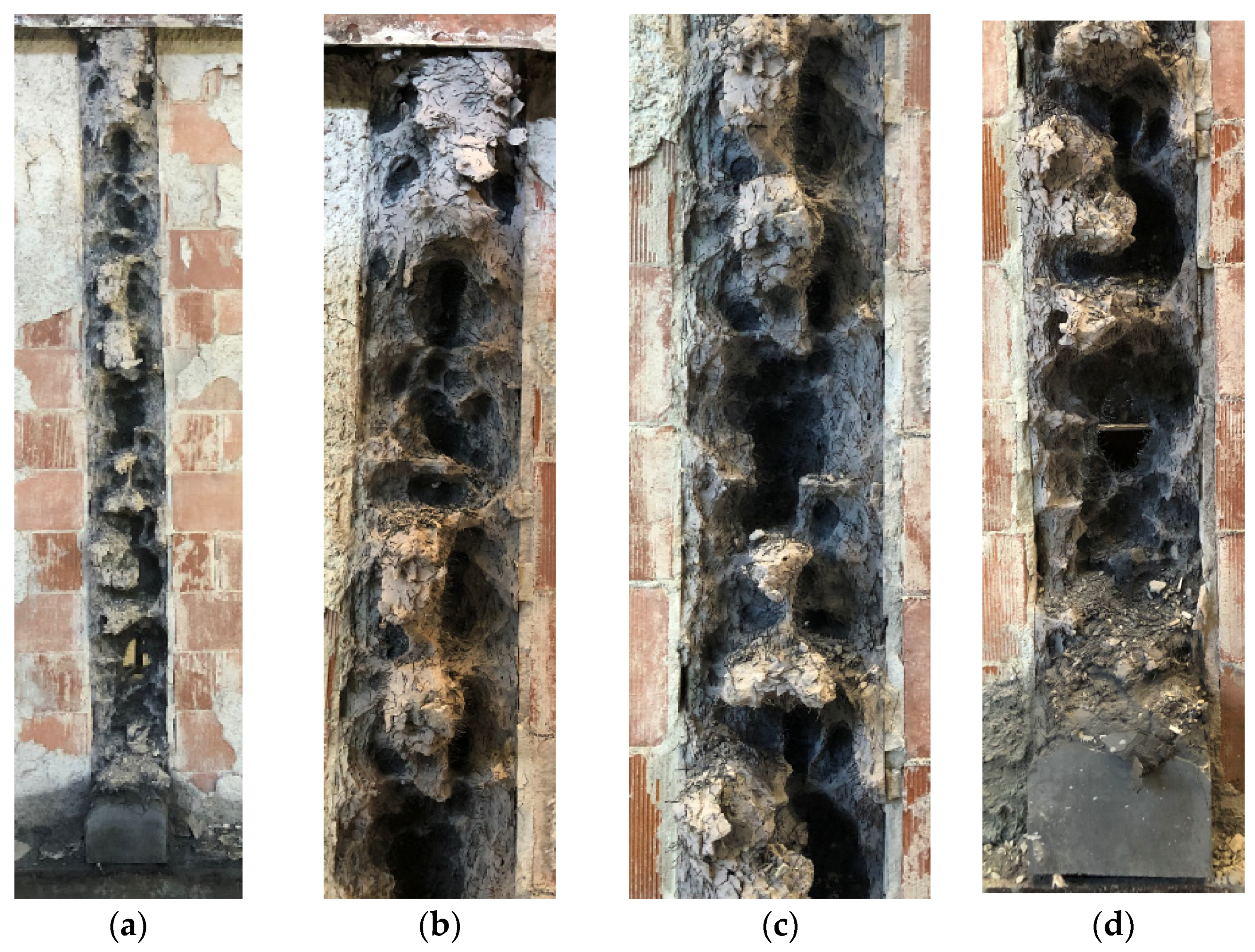

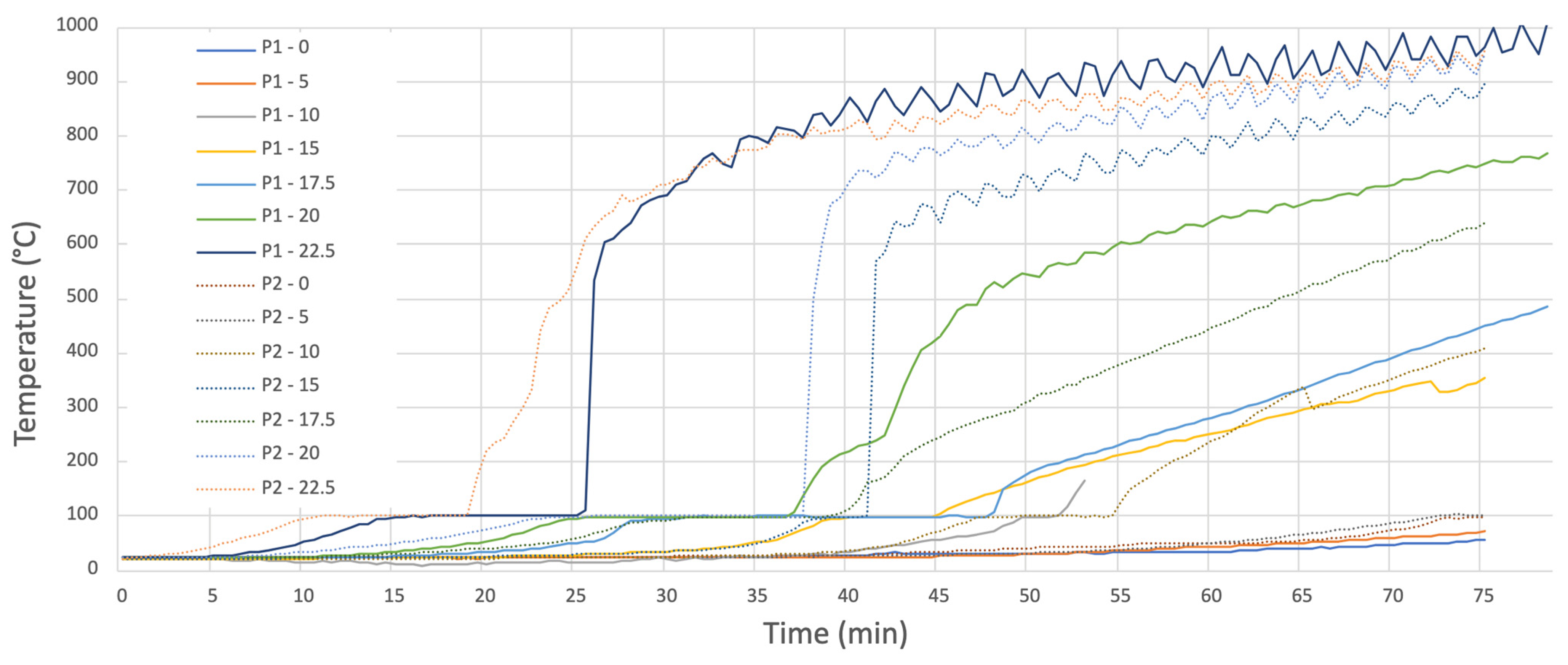
| Materials | kg/m³ |
|---|---|
| Portland cement | 490 |
| Silica fume | 269 |
| Fly ash | 235 |
| Quartz sand | 1025.5 |
| Water | 179 |
| Superplasticizer additive | 17.6 |
| Steel fibers | 120 |
| PVA fibers | 6 |
| COLUMN 1 | COLUMN 2 | |||
|---|---|---|---|---|
| Section | Ave (mm) | Spalling | Ave (mm) | Spalling |
| 1 | 66.8 | 27% | 57.2 | 23% |
| 2 | 179.6 | 72% | 61.6 | 25% |
| 3 | 184.0 | 74% | 104.0 | 42% |
| 4 | 134.6 | 54% | 122.0 | 49% |
| 5 | 130.0 | 52% | 46.8 | 19% |
| 6 | 122.8 | 49% | 135.4 | 54% |
| 7 | 158.2 | 63% | 154.2 | 62% |
| 8 | 91.2 | 36% | 165.0 | 66% |
| 9 | 62.2 | 25% | 134.2 | 54% |
| 10 | 126.2 | 50% | 120.4 | 48% |
| 11 | 129.0 | 52% | 114.6 | 46% |
| 12 | 81.6 | 33% | 93.0 | 37% |
| Average spalling | 49% | Average spalling | 44% | |
Disclaimer/Publisher’s Note: The statements, opinions and data contained in all publications are solely those of the individual author(s) and contributor(s) and not of MDPI and/or the editor(s). MDPI and/or the editor(s) disclaim responsibility for any injury to people or property resulting from any ideas, methods, instructions or products referred to in the content. |
© 2023 by the authors. Licensee MDPI, Basel, Switzerland. This article is an open access article distributed under the terms and conditions of the Creative Commons Attribution (CC BY) license (https://creativecommons.org/licenses/by/4.0/).
Share and Cite
Christ, R.; Lerner, L.R.; Ehrenbring, H.Z.; Pacheco, F.; Bolina, F.L.; Poleto, G.; Gil, A.M.; Tutikian, B.F. Evaluation of Ultra-High-Performance Concrete Columns at High Temperatures after 180 Days of Curing. Buildings 2023, 13, 2254. https://doi.org/10.3390/buildings13092254
Christ R, Lerner LR, Ehrenbring HZ, Pacheco F, Bolina FL, Poleto G, Gil AM, Tutikian BF. Evaluation of Ultra-High-Performance Concrete Columns at High Temperatures after 180 Days of Curing. Buildings. 2023; 13(9):2254. https://doi.org/10.3390/buildings13092254
Chicago/Turabian StyleChrist, Roberto, Lucas Rafael Lerner, Hinoel Z. Ehrenbring, Fernanda Pacheco, Fabricio L. Bolina, Giovana Poleto, Augusto Masiero Gil, and Bernardo F. Tutikian. 2023. "Evaluation of Ultra-High-Performance Concrete Columns at High Temperatures after 180 Days of Curing" Buildings 13, no. 9: 2254. https://doi.org/10.3390/buildings13092254






